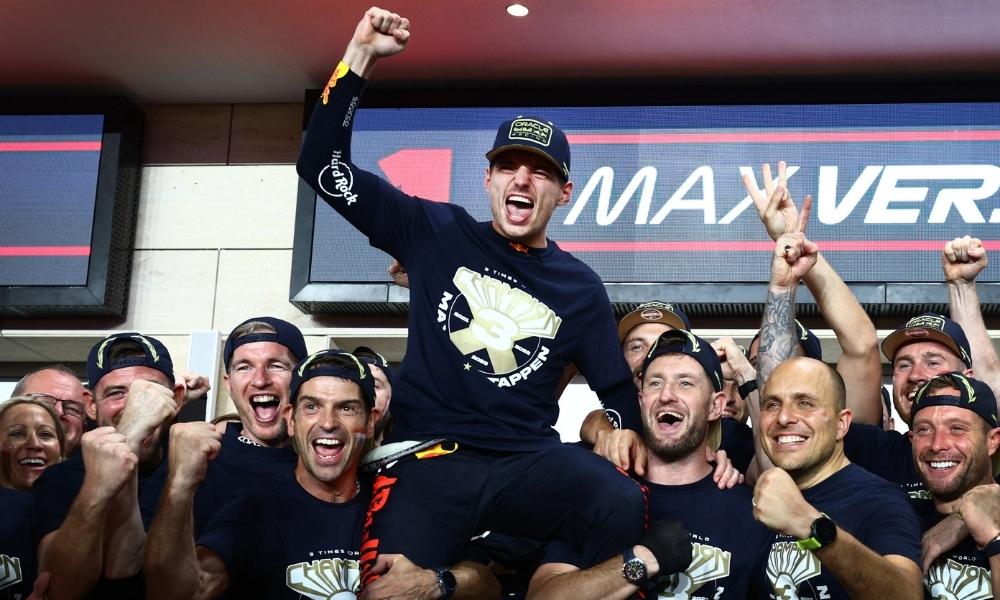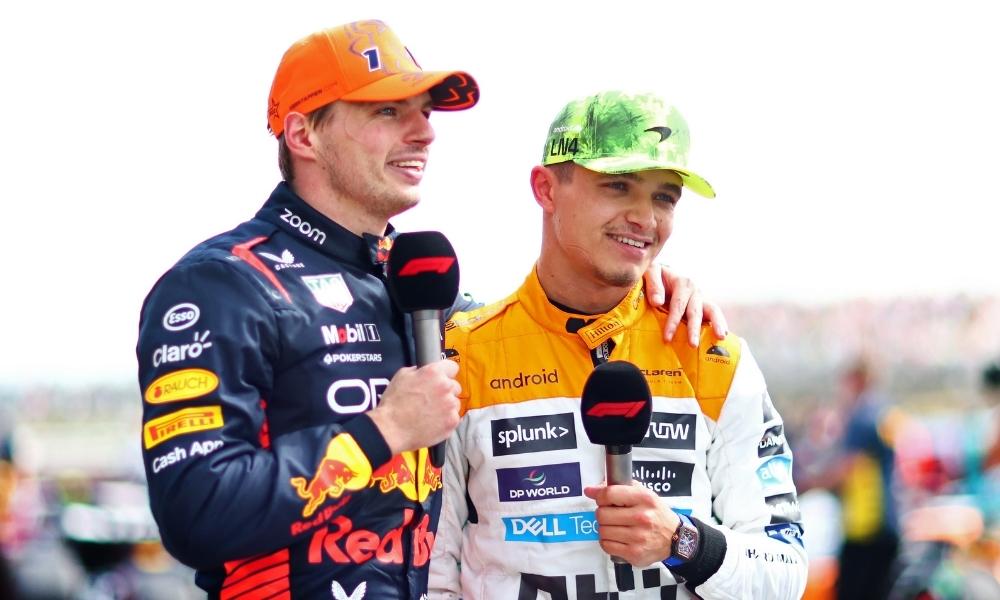The 14th edition of SportsPro’s 50 Most Marketable (50MM) Athletes list has been unveiled and there is once again strong representation from Formula One drivers.
In recent years, the popularity of Formula One has skyrocketed, with a combination of the pandemic, Netflix’s Drive to Survive docuseries, and a close championship battle between Max Verstappen and Lewis Hamilton creating the perfect storm to market the series.
The methodology behind 50MM may have evolved over the years, but its goal of painting a picture of the increasingly complicated world of athlete marketability remains as true as ever. This year, NorthStar Solutions Group has built a comprehensive model to rank sportsmen and women based on three key factors: Brand Strength, Total Addressable Market (TAM), and ECON – Triple Bottom Line.
This refined approach has seen four Formula One drivers make the list this year, one fewer than the 2022 edition. Hamilton (seventh), Verstappen (tenth), Lando Norris (25th) and Charles Leclerc (28th) all feature, but George Russell and Sergio Perez drop out of the top 50 following appearances last year. Interestingly, no teammates make the list, with Mercedes, Red Bull, Ferrari and McLaren all represented.
“While there was one less driver compared to last year, there were more drivers in the top ten this year (two of them) and ranked in the top 25 this year versus only two in the previous year,” says Tom Malkin of NorthStar Solutions Group, the data and analytics partner of 50MM.
“Some of the specific reasons why these drivers have risen in marketability include the following: all Formula One drivers in the top 50 were ranked in the top 20 per cent of environmental ROO, which could indicate that their passion for being more environmentally conscious supports their rise in marketability for this year.
“All Formula One drivers in the top 50 were ranked in the top 20 per cent in audience reach within the TAM Pillar, which could indicate that growing ppularity of the sport and additional media exposure is also helping create an impact for those athletes individually in their marketability.”
Indeed, dominance on the track undeniably has an impact, but evolving audience behaviours – especially among younger generations – mean that there is now much more to an F1 driver’s marketability than simply winning titles.
“While there was one less driver compared to last year, there were more drivers in the top ten this year (two of them) and ranked in the top 25 this year versus only two in the previous year,” says Tom Malkin of NorthStar Solutions Group, the data and analytics partner of 50MM.
“Some of the specific reasons why these drivers have risen in marketability include the following: all Formula One drivers in the top 50 were ranked in the top 20 per cent of environmental ROO, which could indicate that their passion for being more environmentally conscious supports their rise in marketability for this year.
“All Formula One drivers in the top 50 were ranked in the top 20 per cent in audience reach within the TAM Pillar, which could indicate that growing popularity of the sport and additional media exposure is also helping create an impact for those athletes individually in their marketability.”
Indeed, dominance on the track undeniably has an impact, but evolving audience behaviours – especially among younger generations – mean that there is now much more to an F1 driver’s marketability than simply winning titles.

Verstappen closes in on Hamilton
It’s the story that dominated the 2021 Formula One season and defined many new fans’ first experience of the sport. Despite Verstappen’s current dominance, his on-track battles with Hamilton are met with anticipation on the rare occasions that they do cross paths.
While the Brit cannot compete with his Dutch rival for wins at the moment, Verstappen is still unable to reach Hamilton’s level of marketability, even as he slowly edges closer to him on this year’s list.
In terms of global recognition, the Brit transcends the sport, which has been made clear through his consistently high 50MM ranking over the years, even topping the list in 2015. Statistically the greatest driver of all time, his influence stretches far beyond the race track, which has helped him to secure brand deals with the likes of Tommy Hilfiger, Monster Energy and UBS.
Yet what is crucial to Hamilton’s sustained marketability is his authenticity, which accounts for more than half of an athlete’s Brand Strength score in NorthStar’s methodology. The 38-year-old is ranked as the most authentic of all the athletes who were evaluated as part of this year’s 50MM, which is no surprise given his commitment to social and sustainable causes.
🏎️ Lewis Hamilton v Max Verstappen - who's the most marketable? @cianbrittle breaks down #F1's off-track battle. #SP50MM | @NorthStarSG pic.twitter.com/YqTKKRH6ON
— SportsPro (@SportsPro) October 17, 2023
As Formula One’s only Black driver, Hamilton has taken it upon himself to lead the fight against racism, with his push for greater diversity clearly resonating with fans and sponsors alike. In addition, he has also set up the Hamilton Commission, which is committed to improving representation of Black people in UK motorsport, while he is also an investor in several sustainable businesses.
Those actions ensured that Hamilton was one of the top performers within NorthStar’s ECON pillar, which not only incorporates an athlete’s market value and estimated worth, but also their contributions to environmental sustainability and impact on the community.
Just three places behind Hamilton, though, is Formula One’s three-time world champion, who climbs up the list after ranking 33rd in 2022. Cracking the top ten this year highlights just how much the Dutchman’s stock is rising as he enjoys his time at the top of the sport. The fervent support from his ‘Orange Army’ can be seen at many races across Europe, and this is slowly translating into his overall marketability.
Like Hamilton, Verstappen ranks highly for authenticity (seventh overall), which perhaps speaks to his willingness to always speak his mind. Verstappen’s ECON score, meanwhile, was the tenth best of all athletes and he performed well across all three components of the triple bottom line.
So proud of the progress we’ve been making since releasing the Hamilton Commission. Much more to come 🚀 https://t.co/sibQ8Hvufn
— Lewis Hamilton (@LewisHamilton) August 3, 2023
In terms of endorsements, Verstappen is the ambassador for Heineken’s Player 0.0 gaming initiative, while he has also signed a partnership with EA Sports, the rights holder for the official Formula One games. This focus on gaming gives Verstappen a particular boost with a Gen Z audience, which coincidentally is the demographic with which Hamilton’s brand strength falls short.
Plus, a global survey conducted in 2021 by Motorsport Network found that Verstappen is Formula One’s most popular driver with 14.4 per cent of the vote, while Hamilton only managed third behind Norris.
“Because of the success of Max Verstappen at the young age of 26, there is a high possibility that he could overtake Lewis Hamilton in leading the sport in terms of marketability once Hamilton ends up retiring,” Malkin notes.
Leclerc and Norris reach audiences that others can’t
Notably, Norris’ appearance ahead of Hamilton in Motorsport Network’s global fan survey highlights the shifting attitudes of Formula One’s audience, while it also points to the rising profile of the sport’s younger stars.
As Malkin mentions, Verstappen is very much part of this younger generation and, at 26, he is 12 years Hamilton’s junior. Leclerc is just one month younger than the Red Bull driver, while Norris is only 23 years old.
These drivers saw their marketability start to develop during the pandemic, with many turning to gaming to connect with fans, which was particularly effective for Norris to grow his profile.

“Norris comfortably stood out as the favourite driver with fans 24 and under, and [he] enjoyed unrivalled popularity from female fans,” explains Malkin.
Streaming on websites like Twitch has opened up new avenues for these drivers to connect with a range of different audiences, but this is now having an impact on their wider marketability. Indeed, within NorthStar’s TAM pillar, Leclerc ranks second for audience reach, while Norris isn’t far behind in sixth. That is well ahead of both Verstappen and Hamilton’s scores for that particular driver, which is testament to the fact that Leclerc and Norris aren’t only reaching a large audience, but a diverse audience as well.
Their off-track interests can also be seen in their commercial partnerships. Last year, Leclerc was announced as EA Sports’ first-ever Formula One ambassador ahead of the release of the F1 22 title, which saw the Monegasque driver appear on the cover of the worldwide version of the game.
Meanwhile, Norris’ business endeavours include Quadrant, his gaming and lifestyle brand that claims to combine his love for gaming, lifestyle, content, and apparel. It takes advantage of established content creators to help boost its reach, and Norris’ marketability and popularity ensure merchandise sales remain high.
What about those who missed out?
Sergio Perez and George Russell are the absentees after appearing in last year’s list, although the Mexican does feature within the top 125 athletes, ranking 76th overall.
But why did they drop off the list?
Perez’s audience reach score was 16.6, which was nearly half the score of the Formula One drivers that made the top 50. Leclerc, for example, received an audience reach score of 32.84 and Hamilton was given 30.45. That suggests that while the Red Bull man’s following in his home country of Mexico is indisputable, that popularity doesn’t manifest itself on a global scale.
Meanwhile, the Mexican’s athlete presentation score, which refers to how an individual presents themselves and handles various aspects of their public image, was 2.7. That was about three times less than the lowest scores in that category for the four Formula One drivers that made the top 50. For context, Perez’s score was 13.5 points lower than Hamilton’s, who led in that specific driver among the five Formula One drivers that made the top 125.

Within the ECON pillar, Perez also had a social ROI score of 31, which was the lowest amongst the Formula One drivers that made the list, suggesting he doesn’t have the same social impact as his competitors. He also had a score of 97 within the TAM pillar, which again was the lowest out of all the Formula One drivers.
Given that Russell dropped outside the top 125 entirely, there is no data on Hamilton’s teammate this year. This development is especially surprising after he ranked just two places behind Verstappen in last year’s 50MM.
There is once again no representation in the top 50 from motorsport series other than Formula One, with Joey Logano (96th) and Kyle Busch (107th) from Nascar and IndyCar’s Agustin Canapino (125th) making the top 125.
On this evidence, it remains to be seen whether Formula One’s resurgence is providing a rising tide for other championships. And going into next year, the global motorsport series will be hoping the marketability of its own drivers is immune to the current period of stagnating viewing figures amid Red Bull’s dominance.


